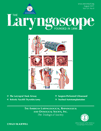Transoral robotic resection and reconstruction for head and neck cancer†
The authors have no funding, financial relationships, or conflicts of interest to disclose.
Abstract
Objectives/Hypothesis:
To evaluate the patterns of failure, survival, and functional outcomes for patients treated with transoral robotic surgery (TORS) and compare these results with those from a cohort of patients treated with concurrent chemoradiation (CRT).
Study Design:
Prospective non-randomized case control study.
Methods:
Between April 2007 and April 2009, 30 patients with head and neck squamous cell carcinoma were treated with primary TORS and adjuvant therapy as indicated on an institutional review board–approved protocol. Patients were evaluated before treatment, after treatment, and at subsequent 3-month intervals after completing treatment to determine their disease and head and neck–specific functional status using the Performance Status Scale for Head and Neck Cancer and the Functional Oral Intake Score (FOIS). Functional scores were compared to a matched group of head and neck patients treated with primary CRT.
Results:
The TORS patient population included 73% stage III-IV and 23% nonsmokers. The median follow-up was 20.4 months (range, 12.8–39.6 months). The 18-month locoregional control, distant control, disease-free survival, and overall survival were 91%, 93%, 78%, and 90%, respectively. Compared to the primary CRT group, TORS was associated with better short-term eating ability (72 vs. 43, P = .008), diet (43 vs. 25, P = .01), and FOIS (5.5 vs. 3.3, P < .001) at 2 weeks after completion of treatment. In contrast to TORS patients who returned to baseline, the CRT group continued to have decreased diet (P = .03) and FOIS (P = .02) at 12 months.
Conclusions:
Our early experience in treating selected head and neck cancers with TORS is associated with excellent oncologic and functional outcomes that compare favorably to primary CRT.




